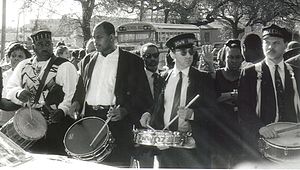- Jazz funeral
-
Jazz funeral is a common name for a funeral tradition with music which developed in New Orleans, Louisiana.
 Drummers at the funeral of jazz legend Danny Barker. Includes Louis Cottrell, (great-grandson of New Orleans' innovative drumming pioneer, Louis Cottrell Sr. and grandson of New Orleans clarinetist Louis Cottrell Jr.) of the Young Tuxedo Brass Band, far right; Louis "Bicycle Lewie" Lederman of the Down & Dirty Brass band, second from right.
Drummers at the funeral of jazz legend Danny Barker. Includes Louis Cottrell, (great-grandson of New Orleans' innovative drumming pioneer, Louis Cottrell Sr. and grandson of New Orleans clarinetist Louis Cottrell Jr.) of the Young Tuxedo Brass Band, far right; Louis "Bicycle Lewie" Lederman of the Down & Dirty Brass band, second from right.
The term "jazz funeral" was long in use by observers from elsewhere, but was generally disdained as inappropriate by most New Orleans musicians and practitioners of the tradition. The preferred description was "funeral with music"; while jazz was part of the music played, it was not the primary focus of the ceremony. This reluctance to use the term faded significantly in the final 15 years or so of the 20th century among the younger generation of New Orleans brass band musicians more familiar with the post-Dirty Dozen Brass Band funk influenced style than the older traditional jazz New Orleans style. (See also: Let Me Do My Thang: Rebirth Brass Band- a documentary filmed and edited by Keith Reynaud, Jr.)
The tradition arises from African spiritual practices, French and Spanish martial musical traditions, and uniquely African-American cultural influences. The tradition was widespread among New Orleanians across ethnic boundaries at the start of the 20th century. As the common brass band music became wilder in the years before World War I, some white New Orleanians considered the hot music disrespectful, and such musical funerals became rare among the city's white citizens. For much of the mid-20th century, the Catholic Church officially frowned on secular music at funerals, so for generations the tradition was largely confined to African American Protestant New Orleanians. After the 1960s it gradually started being practiced across ethnic and religious boundaries. Most commonly such musical funerals are done for individuals who are musicians themselves, connected to the music industry, or members of various social aid & pleasure clubs or Carnival krewes who make a point of arranging for such funerals for members.
The organizers of the funeral arrange for hiring the band as part of the services. When a respected fellow musician or prominent member of the community dies, some additional musicians may also play in the procession as a sign of their esteem for the deceased.
 Musicians play for a funeral leaving Saint Augustine Church in the Treme neighborhood; Dr. Michael White in foreground.
Musicians play for a funeral leaving Saint Augustine Church in the Treme neighborhood; Dr. Michael White in foreground.
A typical jazz funeral begins with a march by the family, friends, and a brass band from the home, funeral home or church to the cemetery. Throughout the march, the band plays somber dirges and hymns. A change in the tenor of the ceremony takes place, after either the deceased is buried, or the hearse leaves the procession and members of the procession say their final good bye and they "cut the body loose". After this the music becomes more upbeat, often starting with a hymn or spiritual number played in a swinging fashion, then going into popular hot tunes. There is raucous music and cathartic dancing where onlookers join in to celebrate the life of the deceased. Those who follow the band just to enjoy the music are called the second line, and their style of dancing, in which they walk and sometimes twirl a parasol or handkerchief in the air, is called second lining.
Some younger funk and hip hop oriented brass bands often dispense with the dirges and hymns altogether, or perform only the traditional tune "Just a Closer Walk With Thee."
One tune sometimes used in this upbeat portion of the parade is the "New Second Line" march, which was featured in the jazz-funeral marches in the James Bond movie Live and Let Die.
Notable people who have received jazz funerals
- Ed Bradley
- Paul Barbarin
- Danny Barker
- Louis Cottrell, Jr.
- Ernie K-Doe
- Snooks Eaglin
- Helen Hill
- Allan Jaffe, Preservation Hall proprietor
- Anthony Lacen (Tuba Fats)
- Austin Leslie
- Professor Longhair
- Allison "Tootie" Montana
- Paolo Mantovani
- Ernest "Doc" Paulin
- Alphonse Picou
- Ike Turner
- Soulja Slim
See also
External links
- Let Me Do My Thang: Rebirth Brass Band — a documentary filmed and edited by Keith Reynaud, Jr. http://southernspaces.org/2006/let-me-do-my-thang-rebirth-brass-band
- Nick Spitzer, "Rebuilding the 'Land of Dreams:' Expressive Culture and New Orleans' Authentic Future" Southern Spaces 29 August 2006 http://southernspaces.org/2006/rebuilding-land-dreams-expressive-culture-and-new-orleans-authentic-future
- Nick Spitzer, "Love and Death at Second Line" Southern Spaces, 20 February 2004. http://southernspaces.org/2004/love-and-death-second-line
- "Jazz Funerals," Religion & Ethics Newsweekly no. 722 (Jan. 30, 2004)
- Jazz Funeral of Anthony "Tuba Fats" Lacen, January 18, 2004
- Jazz Funeral New Orleans Online
Louisiana roots music and dance - Bounce
- Brass Bands
- Cajun Jig (One Step)
- Cajun Jitterbug (Two Step)
- Cajun music* Creole music
- Dixieland
- Jazz
- Jazz funeral
- Louisiana blues
- New Orleans blues
- New Orleans hip hop
- New Orleans R&B
- Second line
- Swamp blues
- Swamp pop
- Zydeco
- Zydeco (dance)
Categories:- Jazz culture
- Culture of New Orleans, Louisiana
- Funerals
Wikimedia Foundation. 2010.
